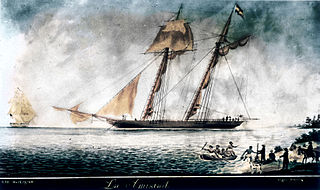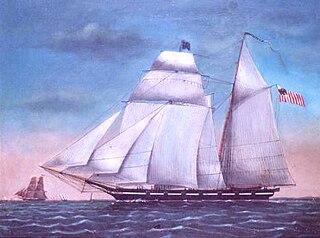Related Research Articles

The United States Revenue Cutter Service was established by an act of Congress on 4 August 1790 as the Revenue-Marine upon the recommendation of Secretary of the Treasury Alexander Hamilton to serve as an armed customs enforcement service. As time passed, the service gradually gained missions either voluntarily or by legislation, including those of a military nature. It was generally referred to as the Revenue-Marine until 31 July 1894, when it was officially renamed the Revenue Cutter Service. The Revenue Cutter Service operated under the authority of the U.S. Department of the Treasury. On 28 January 1915, the service was merged by an act of Congress with the United States Life-Saving Service to form the United States Coast Guard.
Three vessels of the United States Navy or United States Coast Guard have been named USS Onondaga, after Onondaga Lake and Onondaga County, New York.
Bibb may refer to:

Harriet Lane was a revenue cutter of the United States Revenue Cutter Service and, on the outbreak of the American Civil War, a ship of the United States Navy and later Confederate States Navy. The craft was named after the niece of senator and later United States President, James Buchanan; during his presidency, she acted as First Lady. The cutter was christened and entered the water for the Revenue Service in 1859 out of New York City, and saw action during the Civil War at Fort Sumter, New Orleans, Galveston, Texas, and Virginia Point. The Confederates captured her in 1863, whereupon she was converted to mercantile service. Union forces recaptured her at the end of war. The U.S. Navy declared her unfit for service and sold her. New owners out of Philadelphia renamed her Elliot Ritchie. Her crew abandoned her at sea in 1881.

Washington was a revenue cutter that served in the United States Revenue Cutter Service and in the United States Navy. She discovered, boarded, and captured La Amistad after the slaves onboard had seized control of that schooner in an 1839 mutiny.
The history of the United States Coast Guard goes back to the United States Revenue Cutter Service, which was founded on 4 August 1790 as part of the Department of the Treasury. The Revenue Cutter Service and the United States Life-Saving Service were merged to become the Coast Guard per 14 U.S.C. § 1 which states: "The Coast Guard as established January 28, 1915, shall be a military service and a branch of the armed forces of the United States at all times." In 1939, the United States Lighthouse Service was merged into the Coast Guard. The Coast Guard itself was moved to the Department of Transportation in 1967, and on 1 March 2003 it became part of the Department of Homeland Security. However, under 14 U.S.C. § 3 as amended by section 211 of the Coast Guard and Maritime Transportation Act of 2006, upon the declaration of war and when Congress so directs in the declaration, or when the President directs, the Coast Guard operates as a service in the Department of the Navy.
USS Bibb was a United States Coast and Geodetic Survey vessel that performed survey work during the American Civil War. In 1864, when Washington, D.C. appeared under threat after Lt Gen. Jubal Early’s Confederate army crossed the Potomac River, Bibb was commandeered and armed by the Union Navy.
USS Corwin was a steamer acquired by the Union Navy during the American Civil War. She was used by the Union Navy to patrol navigable waterways of the Confederacy to prevent the South from trading with other countries.

The United States Revenue Cutter Wolcott was one of 13 revenue cutters of the Morris-Taney Class to be launched. Named after Secretaries of the Treasury and Presidents of the United States, these cutters were the backbone of the United States Revenue-Marine for more than a decade. Samuel Humphreys designed these cutters for roles as diverse as fighting pirates, privateers, combating smugglers and operating with naval forces. He designed the vessels on a naval schooner concept. They had Baltimore Clipper lines. The vessels built by Webb and Allen, designed by Isaac Webb, resembled Humphreys' but had one less port.
USRC Walter Forward was a schooner constructed for service with the United States Revenue-Marine. She was more commonly known as USRC Forward. Forward served with the United States Army and United States Navy in Mexican waters during the Mexican–American War and was commended for her actions during the Tabasco River landings by Commodore Matthew C. Perry, U.S. Navy. After the war, she was transferred to the United States Coast Survey for a short time as USCS Walter Forward before being returned to the Revenue-Marine for service during the 1850s and the American Civil War.
Dallas has been the name of more than one ship of the United States Revenue Cutter Service and United States Coast Guard, and may refer to:
USS Rush has been the name of more than one United States Navy ship, and may refer to:
Bollinger Shipyards is an American constructor of ships, workboats and patrol vessels. Its thirteen shipyards and forty drydocks are located in Louisiana and Texas. Its drydocks range in capacity from vessels of 100 tons displacement to 22,000 tons displacement. The firm was founded in 1946.
USS Van Buren was a schooner that served as part of the United States Revenue Cutter Service. The ship was named after Martin Van Buren, the eighth president of the U.S. The ship was commissioned and set sail on 2 December 1839, and served a regular tour of duty with the Revenue Service. During the Second Seminole War, the ship was transferred to the United States Navy, and served as a support ship to troops along the coasts of Florida's rivers.
USS Vigilant may refer to several ships of the United States Navy:
USRC Vigilant may refer to various ships of the United States Revenue-Marine (1790–1894) and United States Revenue Cutter Service (1894–1915):
The revenue cutter USRC George M. Bibb was an iron-hulled steamboat built at Pittsburgh in 1845, named after the then-Secretary of the Treasury George M. Bibb, which served on blockade duty during the Mexican–American War in 1846, and was transferred to the United States Coast Survey in 1847. Its engines were salvaged for a second Bibb that is sometimes considered to be a rebuild of the George M. Bibb.
Captain Alexander V. Fraser, U. S. Revenue Marine, was an American seaman, who served as the first Chief of the Revenue Marine Bureau, Department of the Treasury, one of the predecessor agencies of the United States Coast Guard.

USRCSurveyor was a ship of the United States Revenue Marine captured by the United Kingdom during the War of 1812. Despite the vessel's loss, the "gallant and desperate" defense of her crew against a superior force of the Royal Navy and the Corps of Royal Marines is commemorated by the United States Coast Guard. Along with the Royal Navy frigate which bested her in battle, HMS Narcissus, Surveyor is among six legendary ships memorialized in the lyrics of the Coast Guard march "Semper Paratus".
USCGC Chase can refer to the following ships of the United States Coast Guard:
References
- This article incorporates text from the public domain Dictionary of American Naval Fighting Ships .The entry can be found here.